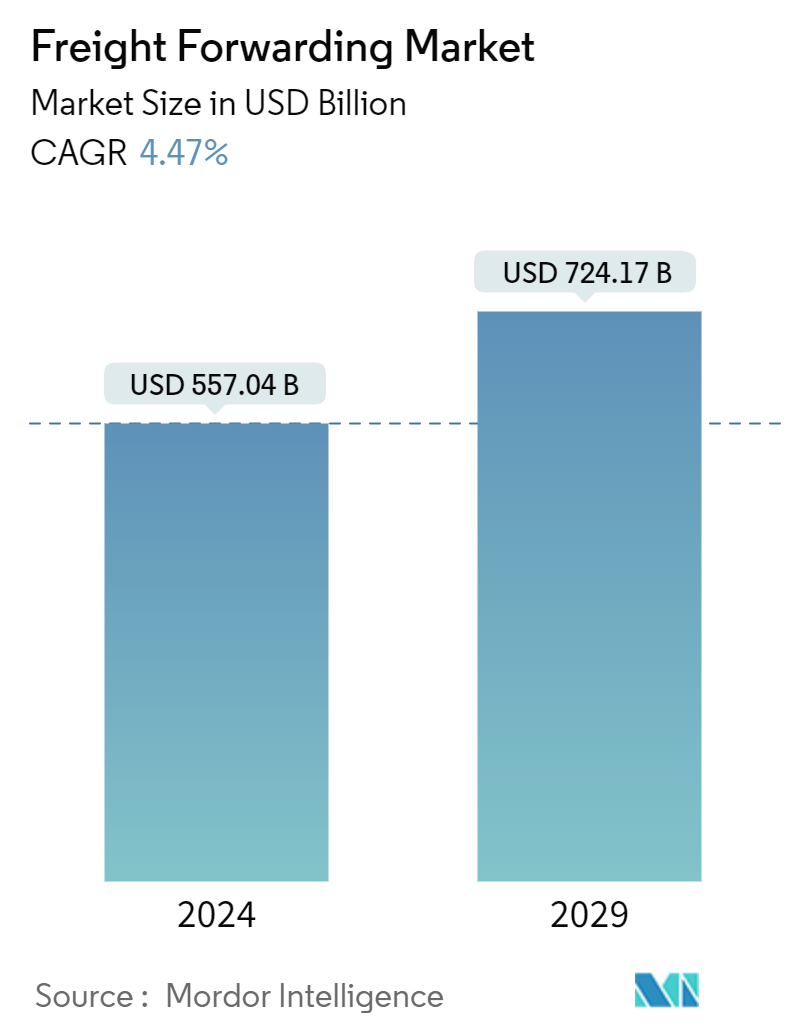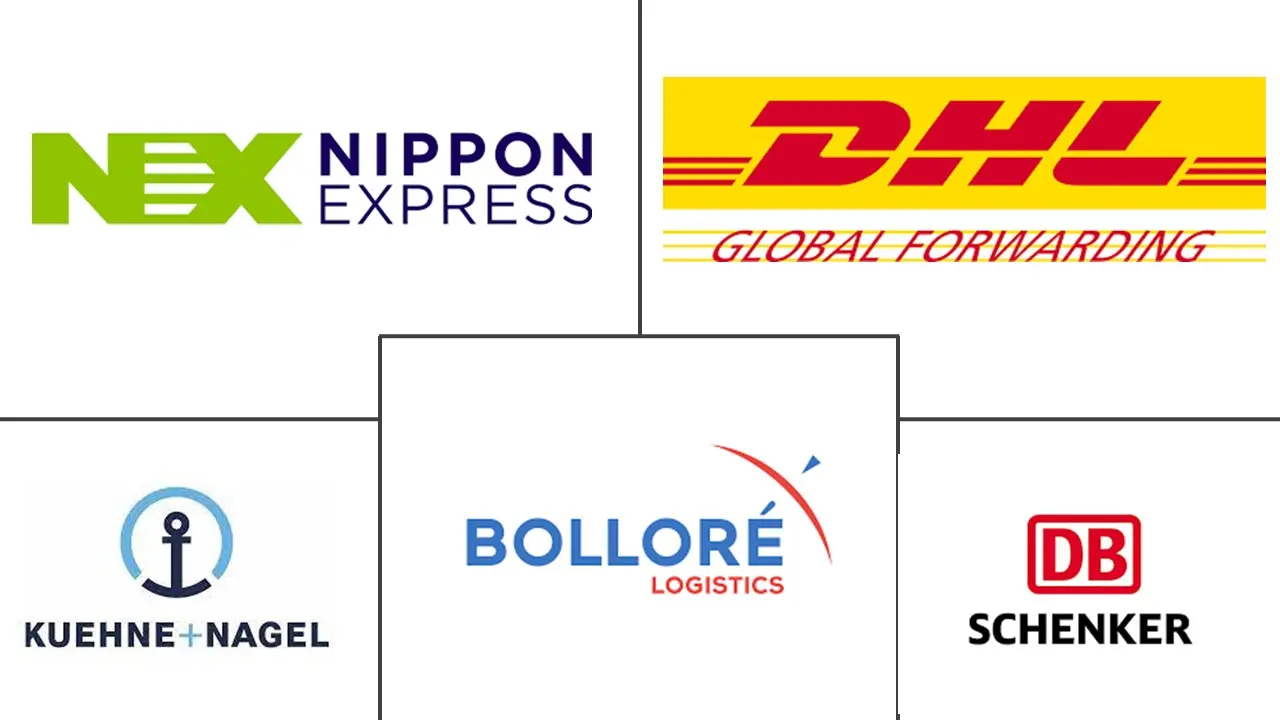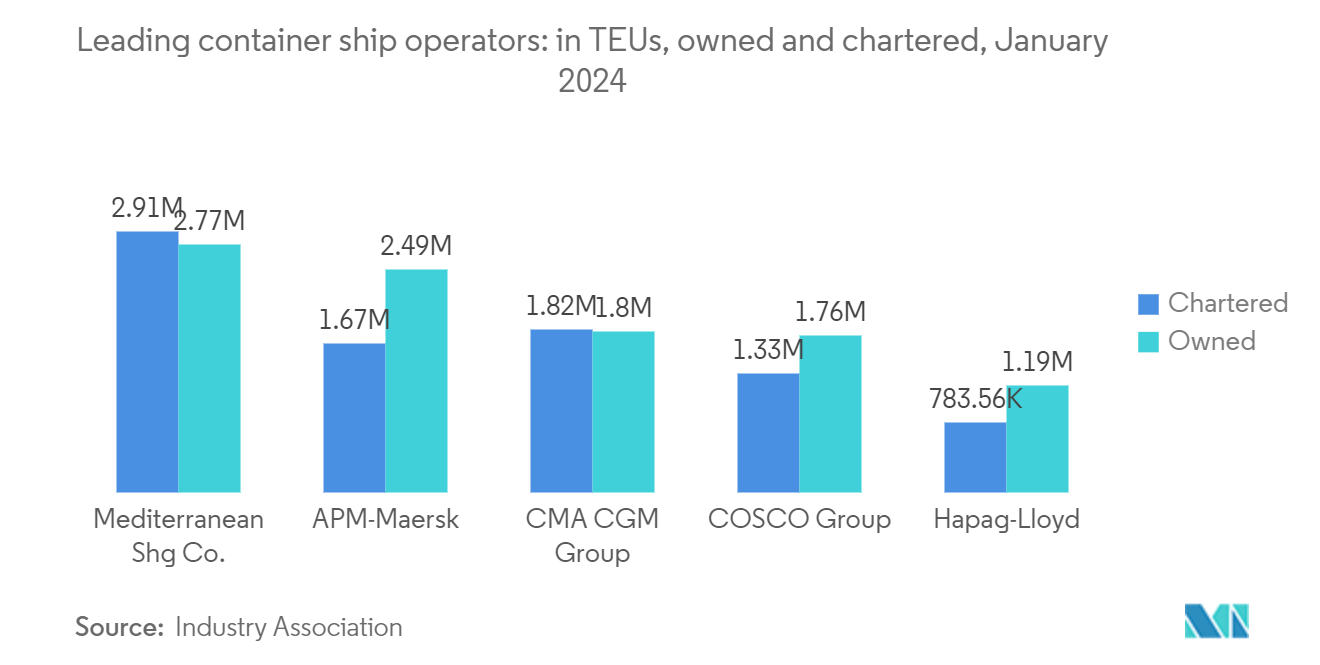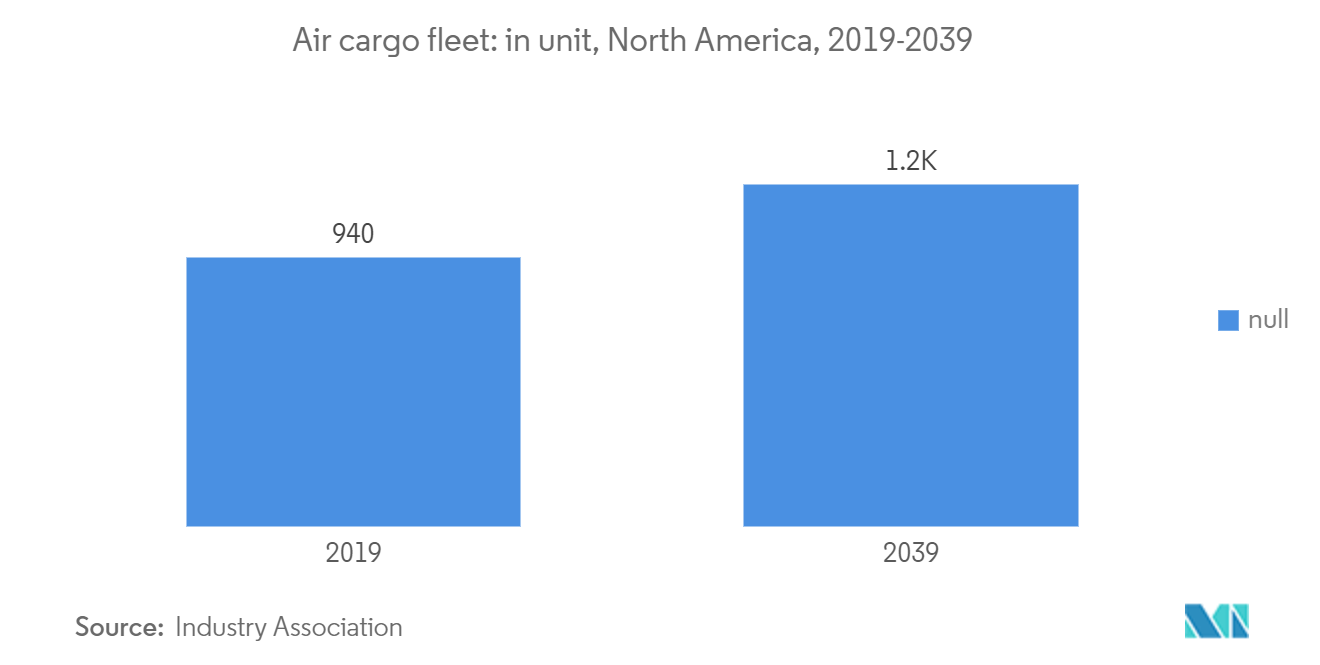Freight Forwarding Market Size

| Study Period | 2020 - 2029 |
| Market Size (2024) | USD 557.04 Billion |
| Market Size (2029) | USD 724.17 Billion |
| CAGR (2024 - 2029) | 4.47 % |
| Fastest Growing Market | Asia Pacific |
| Largest Market | North America |
Major Players
*Disclaimer: Major Players sorted in no particular order |
Freight Forwarding Industry Analysis
The Freight Forwarding Market size is estimated at USD 557.04 billion in 2024, and is expected to reach USD 724.17 billion by 2029, at a CAGR of 4.47% during the forecast period (2024-2029).
The prompt adoption of technologies such as AI, blockchain, and cloud computing presents a challenge to the freight forwarding industry. The need to invest in these technologies for efficient operation is growing. In September 2023, Uber Freight announced a complete evolution in logistics technologies to power the international movement of goods. With freight worth USD 18 billion, Uber is launching a new generation of products that invest in its advanced technology development abilities and AI-powered software.
In addition to the resumption of freighter schedules, more airline passenger capacity is returning to the market. In 2023, international air travel returned to the pre-pandemic level. The rate remains high but still shallow compared to before the pandemic. Global supply chains persist in being disrupted by trade restrictions involving China, the United States, Russia, Ukraine, and Europe. Suppliers seek other locations to source from outside China, Southeast Asia, and South Asia.
According to freight forwarding industry experts, the ocean forwarding market is evolving faster than expected. The transition from a supply chain struggling to keep up with unprecedented pandemic demand to a weak demand environment is now oversupplied with ships and containers, highlighting the risk of a prolonged global economic downturn. The role of governments is also to facilitate sea routes. As of March 2023, India and Russia considered using the Northern Sea Route, which spans the Arctic, for shipping.
Freight Forwarding Market Trends
Growth In Cross-Border and Sea Trade Driving the Forwarding Industry
The freight forwarding market size has grown significantly, driven by the increasing movement of seaborne transport and cross-border trade. Increasing demand for efficient logistics solutions has been created by the increase in cross-border trade enabled by globalization and international business cooperation.
In September 2023, to monitor progress in the construction of transport, logistics, and trade centers on the borders with China, Russia, the Kyrgyz Republic, Uzbekistan, and the Caspian Sea, Kazakh Deputy Prime Minister, Serik Zhumangarin, convened a meeting of the operational headquarters. The construction work is currently underway and is expected to be completed by 2030. With an accommodation of 10 million tons per year, the terminal can house a 1-million-ton general cargo terminal, a 1.5-million-ton grain terminal, a 5.5-million-ton liquid cargo terminal, and a 2-million-ton universal terminal.
Moreover, the importance of freight forwarding industry services is further strengthened by increased sea trade due to a large volume of goods transported globally. One of the global freight forwarding companies, C.H. Robinson opened a new facility to facilitate trade across the Mexican border in September 2023. In Laredo, Texas, it is the largest cross-border logistics facility. This enlarges the company's footprint at the Mexican border to 1.5 million square feet (about half the area of a large shopping mall), with 400,000 square feet of warehousing space, 154 dock doors, and room for 700 trailers.

Increasing Air Freight to Reduce Time Propelling the Market Growth
The potential for significant freight forwarding industry growth lies in encouraging a higher use of air freight within the logistics sector. Air freight is an efficient option for time-sensitive consignments, particularly for perishable and high-value goods, because of the rapidity of transport.
The air freight forwarding market share of North America is on an exponential rise. As of October 2023, American Airlines Cargo benefited from the expanded winter schedule of more than 12,500 round-trip flights operated by American Airlines between November and March 2024. The carrier operates with increased frequencies on all major international markets, with more than 6,900 widebody flights dedicated to transatlantic routes.
In August 2023, Cargo-partner launched a new air freight solution originating in Chicago to assist clients who export their goods to the United Kingdom. On 1 June 2023, Cargo-partner started a new consolidation of air freight operations from Chicago to Heathrow Airport in London, and it provides support for its domestic and international customers. The service offers weekly departures, with an in-house team of trade experts overseeing the service.

Freight Forwarding Industry Overview
A blend of global freight forwarding companies, regional, and local players exist in the freight forwarding market. Small and medium-sized local operators with limited fleets and storage space continue to serve the market. The market is dominated by the top 20 players, which account for more than 50% of it. DHL Global Forwarding, DB Schenker, Kuehne + Nagel International AG, DSV, Expeditors International, and other global freight forwarding companies in the freight forwarding market. The players need to embrace technology, become more digital, and increase the scale and efficiency of their operations as the freight forwarder market share continues to grow steadily, and there are numerous opportunities. For businesses, an extensive network across the globe is essential. Acquisitions and mergers in the ASEAN logistics market have become increasingly attractive to international investors. As a result of increased business and trade activities, global logistics companies have been expanding in the ASEAN region.
Freight Forwarding Market Leaders
-
Kuehne + Nagel International AG
-
DB Schenker
-
Bollore Logistics
-
DHL Global Forwarding
-
Nippon Express Co., Ltd.
*Disclaimer: Major Players sorted in no particular order

Freight Forwarding Market News
- June 2023: Kuehne+Nagel, a global logistics company, marked an agreement to acquire Morgan Cargo, a leading South African, United Kingdom, and Kenyan freight forwarder specializing in transporting and handling perishable goods. The acquisition strengthens the company's perishables logistics service offering while enhancing connectivity for customers to and from South Africa, the United Kingdom, and Kenya, which includes state-of-the-art cold chain facilities.
- April 2023: DHL Global Forwarding signed an MoU with Turkish Cargo to extend its operations to SMARTIST, a cargo facility for Turkish Cargo at the Istanbul airport. This agreement enhances the company's operation efficiencies and further boosts Istanbul's ability to emerge as a global logistics hub.
Freight Forwarding Market Report - Table of Contents
1. INTRODUCTION
- 1.1 Study Deliverables
- 1.2 Study Assumptions
- 1.3 Scope of the Study
2. RESEARCH METHODOLOGY
- 2.1 Analysis Methodology
- 2.2 Research Phases
3. EXECUTIVE SUMMARY
4. MARKET INSIGHTS
- 4.1 Market Overview
- 4.2 Industry Policies and Regulations
- 4.3 Technology Snapshot and Digital Trends
- 4.4 Insights on Technological Advancements in Freight Forwarding
- 4.5 Value Chain / Supply Chain Analysis
- 4.6 Digitalisation of Freight Forwarding Market
- 4.7 Pricing Analysis and Revenue analysis of Freight Forwarding Market
- 4.8 Regional Insights on Freight Forwarding Market
- 4.9 Impact of COVID-19 on the Market
5. MARKET DYNAMICS
-
5.1 Market Drivers
- 5.1.1 Increasing Demand From E-commerce Sales
-
5.2 Market Restraints
- 5.2.1 Increasing Fuel Costs
-
5.3 Market Opportunities
- 5.3.1 Digitalizing the Logistics Industry
-
5.4 Industry Attractiveness - Porter's Five Forces Analysis
- 5.4.1 Threat of New Entrants
- 5.4.2 Bargaining Power of Buyers/Consumers
- 5.4.3 Bargaining Power of Suppliers
- 5.4.4 Threat of Substitute Products
- 5.4.5 Intensity of Competitive Rivalry
6. MARKET SEGMENTATION
-
6.1 By Mode Of Transport
- 6.1.1 Air Freight Forwarding
- 6.1.2 Ocean Freight Forwarding
- 6.1.3 Road Freight Forwarding
- 6.1.4 Rail Freight Forwarding
-
6.2 By Customer Type
- 6.2.1 B2B
- 6.2.2 B2C
-
6.3 By Application
- 6.3.1 Industrial And Manufacturing
- 6.3.2 Retail
- 6.3.3 Healthcare
- 6.3.4 Oil And Gas
- 6.3.5 Food And Beverages
- 6.3.6 Other Applications
-
6.4 By Geography
- 6.4.1 North America
- 6.4.1.1 United States
- 6.4.1.2 Canada
- 6.4.1.3 Mexico
- 6.4.2 Europe
- 6.4.2.1 Germany
- 6.4.2.2 France
- 6.4.2.3 United Kingdom
- 6.4.2.4 Rest of Europe
- 6.4.3 Asia-Pacific
- 6.4.3.1 China
- 6.4.3.2 Japan
- 6.4.3.3 South Korea
- 6.4.3.4 India
- 6.4.3.5 Rest of Asia-Pacific
- 6.4.4 LAMEA
- 6.4.4.1 Brazil
- 6.4.4.2 South Africa
- 6.4.4.3 GCC
- 6.4.4.4 Rest of LAMEA
7. COMPETITIVE LANDSCAPE
- 7.1 Market Concentration Overview
-
7.2 Company Profiles
- 7.2.1 Kuehne + Nagel International AG
- 7.2.2 DB Schenker
- 7.2.3 Bollore Logistics
- 7.2.4 DHL Global Forwarding
- 7.2.5 Nippon Express Co. Ltd
- 7.2.6 Dsv Global Transports and Logistics
- 7.2.7 The Maersk Group
- 7.2.8 C.H. Robinson
- 7.2.9 Panalpina
- 7.2.10 United Parcel Service
- 7.2.11 FedEx Corp.
- 7.2.12 Walmart Group
- 7.2.13 MGF (Manitoulin Global Forwarding)
- 7.2.14 Hellmann Worldwide Logistics
- 7.2.15 Expeditors International
- 7.2.16 Dachser
- 7.2.17 Imerco
- 7.2.18 Sinotrans India Private Limited
- 7.2.19 CEVA Logistics
- 7.2.20 Uber Freight LLC*
- *List Not Exhaustive
- 7.3 Other Companies
8. MARKET OPPORTUNITIES AND FUTURE TRENDS
9. APPENDIX
- 9.1 Macroeconomic Indicators (GDP Distribution, by Activity, Contribution of the Transport and Storage Sector to Economy)
- 9.2 External Trade Statistics - Exports and Imports, by Product
- 9.3 Insights into the Key Export Destinations and Import Origin Countries
Freight Forwarding Industry Segmentation
Freight forwarding refers to the coordination and transport of goods from one place to another using one or more carriers by air, sea, rail, or road. The principles of freight forwarding focus on the cost-effective and efficient transfer of goods that are always kept in reasonable condition during transport.
A complete freight forwarding industry analysis, comprising the assessment of the economy and contribution of sectors in the economy, freight forwarding industry overview, market size estimation for key segments, and emerging trends in the market segments, market dynamics, freight forwarder market share, geographical trends, and the COVID-19 impact is included in the report.
The freight forwarding market is segmented by mode of transport (air freight forwarding, ocean freight forwarding, road freight forwarding, rail freight forwarding), customer type (B2C and B2B), application (industrial and manufacturing, retail, healthcare, oil and gas, food and beverages, and other applications), and geography (North America, Europe, Asia-Pacific, and LAMEA). The report offers freight forwarding market size, forecasts and freight forwarder market share for all the above-mentioned segments in value (USD).
| By Mode Of Transport | Air Freight Forwarding | |
| Ocean Freight Forwarding | ||
| Road Freight Forwarding | ||
| Rail Freight Forwarding | ||
| By Customer Type | B2B | |
| B2C | ||
| By Application | Industrial And Manufacturing | |
| Retail | ||
| Healthcare | ||
| Oil And Gas | ||
| Food And Beverages | ||
| Other Applications | ||
| By Geography | North America | United States |
| Canada | ||
| Mexico | ||
| By Geography | Europe | Germany |
| France | ||
| United Kingdom | ||
| Rest of Europe | ||
| By Geography | Asia-Pacific | China |
| Japan | ||
| South Korea | ||
| India | ||
| Rest of Asia-Pacific | ||
| By Geography | LAMEA | Brazil |
| South Africa | ||
| GCC | ||
| Rest of LAMEA |
Freight Forwarding Market Research Faqs
How big is the Freight Forwarding Market?
The Freight Forwarding Market size is expected to reach USD 557.04 billion in 2024 and grow at a CAGR of 4.47% to reach USD 724.17 billion by 2029.
What is the current Freight Forwarding Market size?
In 2024, the Freight Forwarding Market size is expected to reach USD 557.04 billion.
Who are the key players in Freight Forwarding Market?
Kuehne + Nagel International AG, DB Schenker, Bollore Logistics, DHL Global Forwarding and Nippon Express Co., Ltd. are the major companies operating in the Freight Forwarding Market.
Which is the fastest growing region in Freight Forwarding Market?
Asia Pacific is estimated to grow at the highest CAGR over the forecast period (2024-2029).
Which region has the biggest share in Freight Forwarding Market?
In 2024, the North America accounts for the largest market share in Freight Forwarding Market.
What years does this Freight Forwarding Market cover, and what was the market size in 2023?
In 2023, the Freight Forwarding Market size was estimated at USD 532.14 billion. The report covers the Freight Forwarding Market historical market size for years: 2020, 2021, 2022 and 2023. The report also forecasts the Freight Forwarding Market size for years: 2024, 2025, 2026, 2027, 2028 and 2029.
How is the Freight Forwarding Market Segmented?
The Freight Forwarding Market is Segmented by a) Transport: Air Freight Forwarding, Ocean Freight Forwarding, Road Freight Forwarding, Rail Freight Forwarding b) Customer Type: Business to Consumer (B2C), Business to Business (B2B) c) Application: Industrial and Manufacturing, Retail, Healthcare, Oil and Gas, Food and Beverages, and Other Applications
What are the key trends in the Freight Forwarding Market?
The key trends in the Freight Forwarding Market are a) Adoption of digital tools for logistics management, tracking, and data analysis b) Focus on eco-friendly practices and reducing the environmental impact of freight forwarding c) Providing real-time tracking and transparency throughout the shipping process
Freight Forwarding Industry Report
The global freight forwarding market is experiencing significant growth, driven by the expansion of international trade and the increasing complexity of global supply chains. As businesses continue to extend their operations beyond domestic borders, the demand for efficient, reliable, and cost-effective freight forwarding services has surged, further fueled by the rise of e-commerce. The market, segmented by mode of transport including road, maritime, rail, and air, sees road transport dominating due to its accessibility and cost-efficiency for short to medium-distance shipments, while air transport is expected to witness the fastest growth due to its speed and efficiency in handling high-value and time-sensitive goods.
Catering to both business-to-business (B2B) and business-to-consumer (B2C) customer types, with B2B dominating due to intricate supply chain networks, the market is seeing key trends such as the increasing integration of technology and an emphasis on sustainability driving growth, particularly in the B2B segment. Conversely, the B2C segment is witnessing significant growth. Key players, including global freight forwarding companies, are focusing on acquisitions, technology integration, and expanding their global networks to stay competitive.
Industry trends indicate a robust market growth rate, supported by comprehensive industry analysis and industry information. The industry outlook remains positive, with industry reports and industry research highlighting substantial industry sales and industry size. Industry statistics further underscore the market's upward trajectory.
Market data reveals promising market forecasts, with market growth driven by market leaders. The market outlook and market overview provide a detailed perspective, while market predictions and market review offer insights into future developments. Market segmentation helps identify key areas of focus, and market value underscores the economic significance of the sector.
For those seeking more detailed information, a report example and report pdf are available. Research companies continue to analyze and provide valuable insights into the industry, ensuring stakeholders are well-informed and prepared for future opportunities.



